![[Snakeroot Organic Farm logo]](pix/sof.gif)
At dawn
Canoe bow waves are quickly lost
on the shoreside
But go on out of sight
on the lake side.
-1986
The constant swish-swish of skis
On a day long ski.
The constant swish-swish of wiper blades
On a day long drive.
-1990
My dog, trotting barefoot
Steps on a garden slug
And thinks
Nothing of it.
-1999
Word spreads quickly
as I approach the pond.
All becomes quiet.
-1997
Hidden in the vines
a large warted cucumber
jumps out of reach.
A toad!
-1997
Delicate puffs
of marshmallow snow
carefully perched
on a branch,
await the trigger of my hat
to melt their way down my back.
-2010
Deep in the tomato jungle
Fruits of yellow, purple and red
Tell of their readiness
To go to market.
-2010
Sugarin' Chores
Snowflakes hurry through my flashlight beam,
As my boots knead new snow with spring mud,
On my nightly Hajj to keep the boil alive,
For as long as possible until the dawn,
To match the power of the flowing sap,
With my meager evaporator and will.
The prize at the finish line are jars of syrup
And Spring.
-2013
| |
|
| |
|
SINGLE TREES We have seven trees tapped singley, where the sap is collected at each tree. We do this because some of our trees are easy to get to (near the side of the driveway) but hard to reach with maple tubing. The pair pictured here wakes up late and is always a good producer late in the season, even though it is in an open location and not shaded by surrounding trees. This pair of maples is right beside the driveway on your right at the end of the driveway when you drive in. |
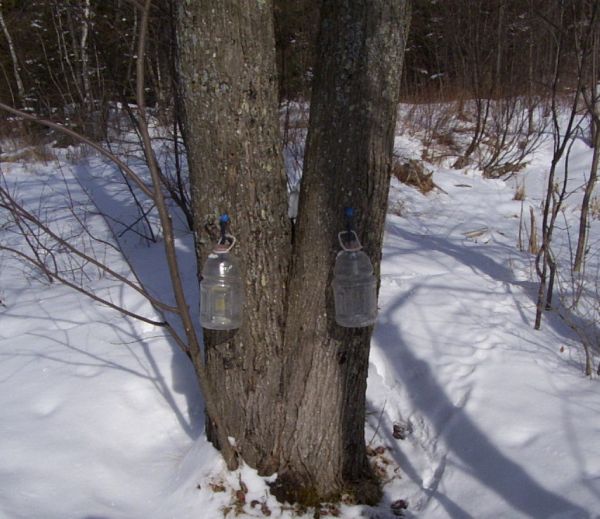
|
|
THE EAST LINE - 69 taps. Here you can see the 5 gallon jug at the end of the East line. In a day with a good sap run, this jug will have to be emptied every 90 minutes. In 2005 there was a ten day period where almost every day was a very good sap run. Shoveling the thirty foot path to the jug must be done after every snow. | 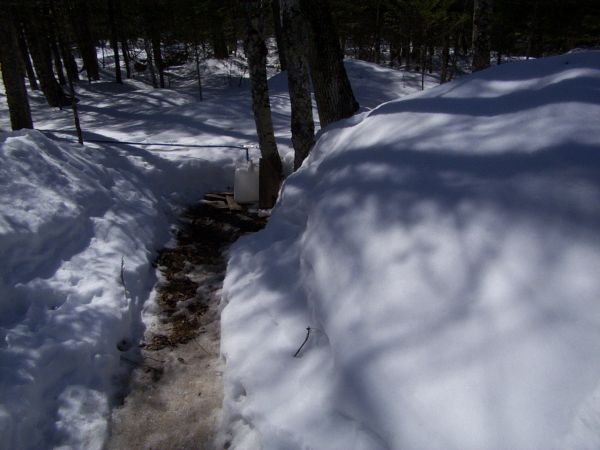 |
This is the view if you walk up to the jug in the previous picture and look back up the line. The East Main Line as it arrives from the sugarbush. This side of the bush has less slope that the west and north branch lines, so the line approaches close to the ground as it arrives to give the line maximum slope. As you can see in times of deep snows, the line can be buried in snow, which means it won't thaw very easily even on a sunny day. On good sap flow days after a heavy snow, such lines need to be cleared of snow so the frozen sap in the lines has a chance to thaw and begin running downhill again. The area where the snow is cleared from around the line is actually two feet off the ground. In the distance you can see a lighter colored branch line as it heads down to the main line. |
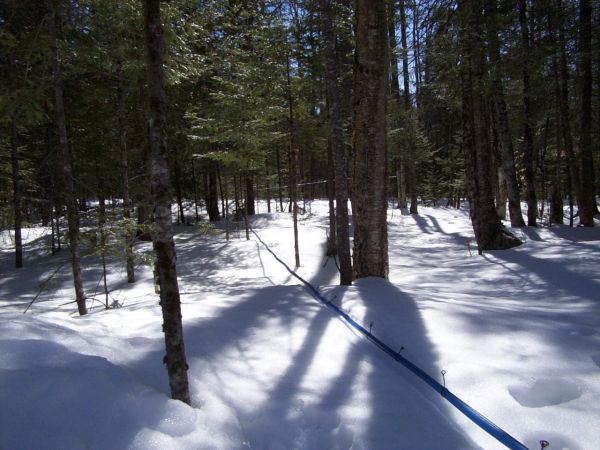
|
|
THE WEST LINE - 54 taps. You can see the difference in this picture as the last one foot extension on the line is the regular blue maple line. Regular hardware store fittings for ½" plastic pipe fits both types of line. |
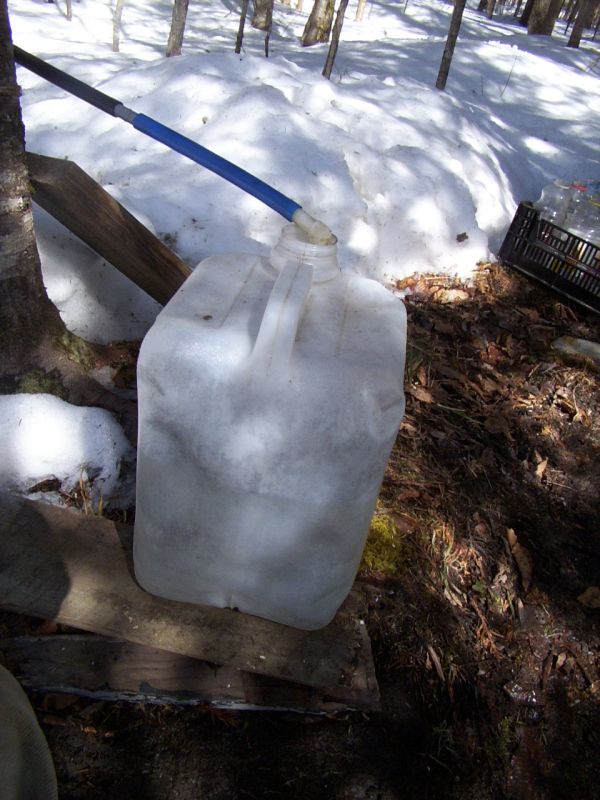
|
|
THE NORTH LINE (30 taps) Here you can see the flow rate is pretty fast, and this keeps up for six to eight hours on a good sap day. After several days in a row like this, panic sets in as we begin to run out of sap storage space. Next to the barrels you can see a stack of ½ gallon recycled juice jugs in trays. We have enough of these to hold another 50 gallons of sap. Our evaporator will boil down between 40-50 gallons in a day if we boil from 7am to 10 pm. This makes for a long day. |
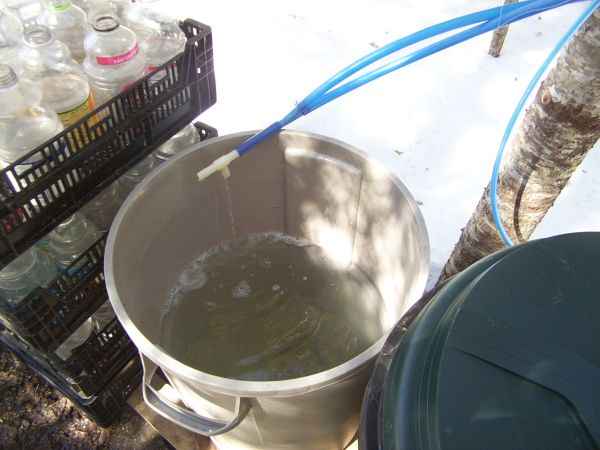
|
|
Stepping back from the last picture we see the two 30 gallon barrels with the jugs stacked next to them. On the left is the West Line and on the right is the Middle Line, with its 24 taps. One of the reasons this site was chosen for the new sugarhouse was that for most of the day the sap jugs are not sitting in the sun. This is not especially important early in the season, but as season winds down with warmer weather, the sun-warmed sap can sour quickly. This photo was taken at about 11 in the morning. |
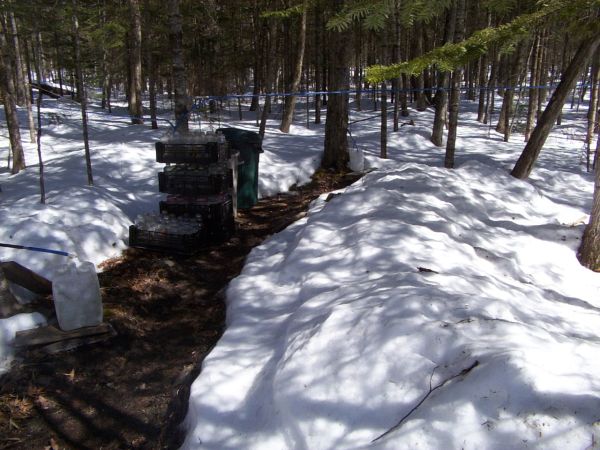
|
|
THE SUGARHOUSE It also has a steam vent which has prevented clouds from forming in the sugarhouse on windless days. The vent can be partially closed on rainy days and completely closed for the off-season. The top of the steam vent propped wide open can be seen next to the stovepipe. Plastic sides and a plastic skylight over the evaporator provide plenty of light until just after dusk, when the flashlights come out. |
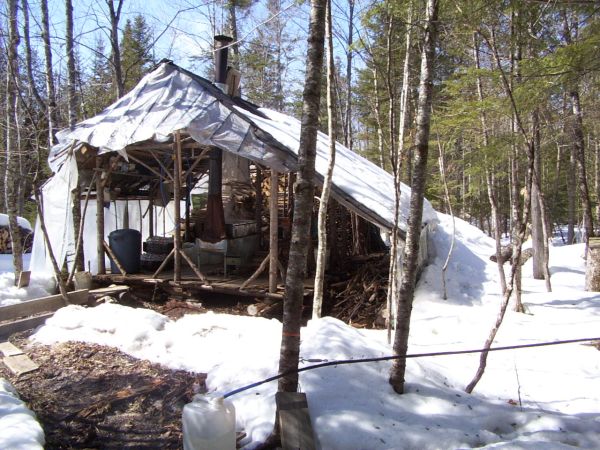
|
|
INSIDE THE SUGARHOUSE On the right is the evaporator and on the left is a third barrel (of four), more trays of ½ gal. jugs, and the seven 5 gallon jugs, all holding sap waiting its turn to be boiled. Additionally we have six 2½ gal water jugs; all told our storage capacity is around 250 gallons, not including the evaporator itself, which holds 15 gallons when full. |
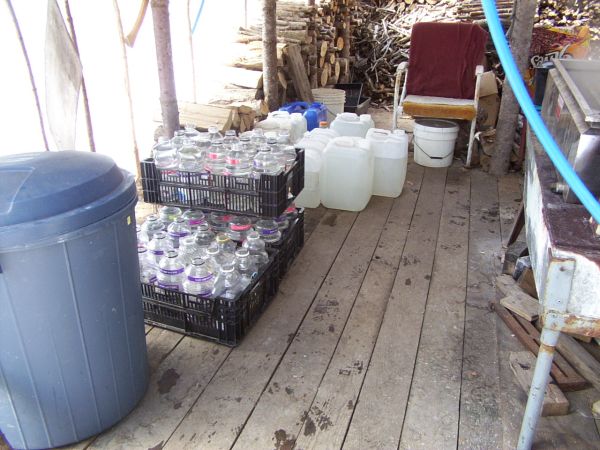
|
|
IT ALL COMES DOWN It is at this point that a few wisps of steam can be noticed wafting above the evaporator. Ten minutes later the roar of the fire is drowned out by the rush of the boil, a sound reminiscent of a waterfall that signals sap is being turned in to syrup. The evaporator fire will need re-stoking every 45 minutes to an hour. |
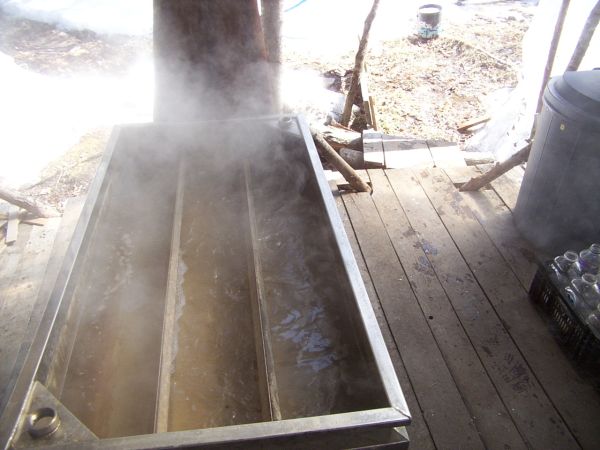
|
|
The formerly smooth surface is now jumping with excitement in every corner of the evaporator. Steam bellows forth, up into the steam vent, instantly clouding the glasses of any who attempt a closer look. Mere sap is being turned into mighty syrup! Through the fired hours of evaporation and carmelization, the alchemy of transformation occurs where the slightly sweet sap of a local tree is turned into a highly sweet and uniquely flavorful syrup sought by millions to lift their spirits on a pancake morning. The maple steam and the roar of the boil last only a few weeks each year, and occur in all the world only in a relativeley small region of northeastern North America; but within that time and space can be experienced and even performed by anyone wishing to tap a tree and to light a fire. |
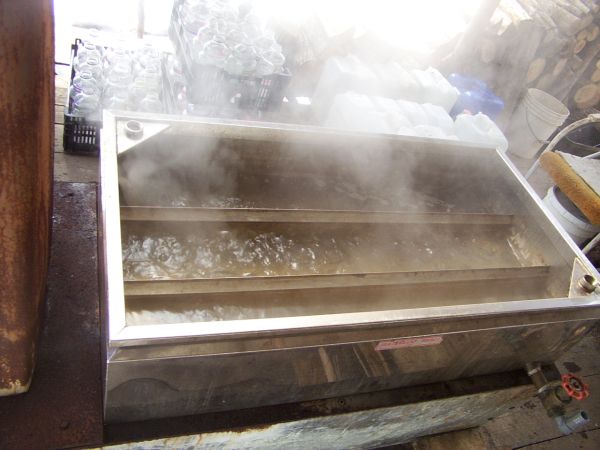
|
|
In the view of the sugarhouse, you can see how the snow has melted away from the stovepipe and steam vent. In 2004, the roof over the evaporator was improved by adding a board roof covered with roll roofing. The rest of the roof covering the end with the firewood is still the original used greenhouse plastic, which allows much more light into the sugarhouse, as can be seen in the next picture. |
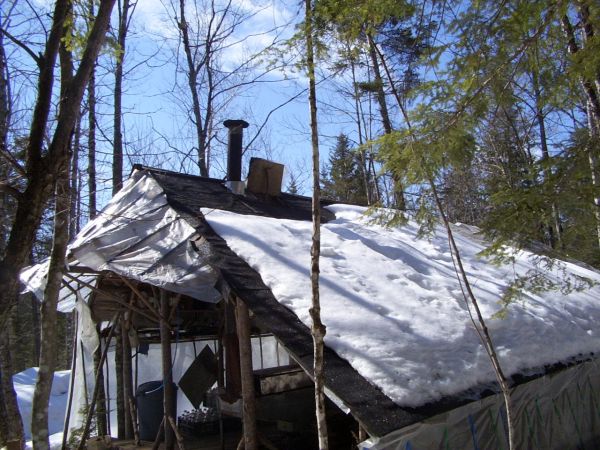
|
|
Just a week away from the end of the 2005 sugaring season, you can see there is still plenty of firewood left. Better too much than too little! Much of this wood was put under cover the previous fall and is not quite dry enough for prime burning wood, but will be perfect for the 2006 season. At the start of the season, the firewood came right up to the back of the chair, full from one side to the other. |
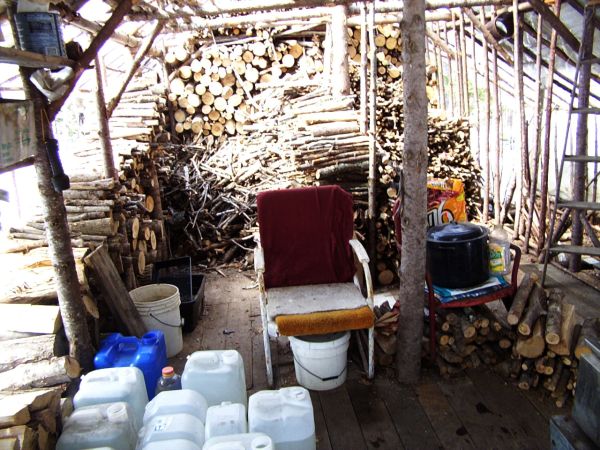
|

 More
More
